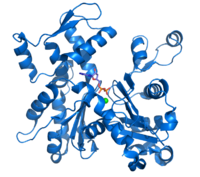
Photo from wikipedia
Transient transcription machineries play important roles in the dynamic modulation of gene expression and the sequestered regulation of cellular networks. The present study emulates such processes by designing artificial reaction… Click to show full abstract
Transient transcription machineries play important roles in the dynamic modulation of gene expression and the sequestered regulation of cellular networks. The present study emulates such processes by designing artificial reaction modules consisting of transcription machineries that guide the transient synthesis of catalytic DNAzymes, the transient operation of gated DNAzymes, and the temporal activation of an intercommunicated DNAzyme cascade. The reaction modules rely on functional constituents that lead to the triggered activation of transcription machineries in the presence of the nucleoside triphosphates oligonucleotide fuel, yielding the transient formation and dissipative depletion of the intermediate DNAzyme(s) products. The kinetics of the transient DNAzyme networks are computationally simulated, allowing to predict and experimentally validate the performance of the systems under different auxiliary conditions. The study advances the field of systems chemistry by introducing transcription machinery-based networks for the dynamic control over transient catalysis—a primary step toward life-like cellular assemblies.
Journal Title: ACS Nano
Year Published: 2022
Link to full text (if available)
Share on Social Media: Sign Up to like & get
recommendations!